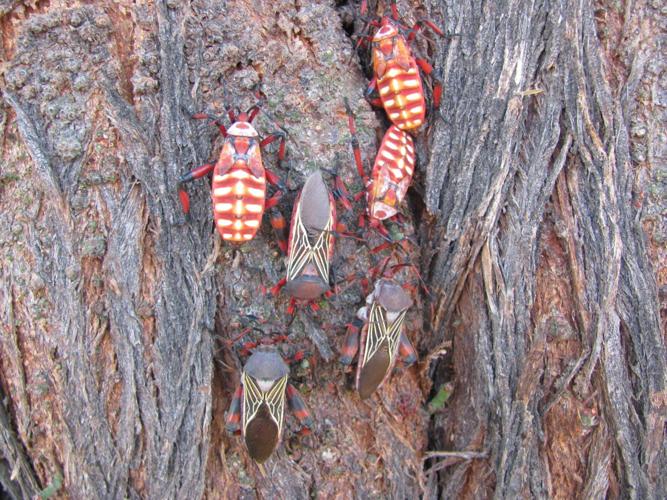Giant mesquite bugs, imposing in appearance but harmless to humans, are coming down from their normal domain in the tops of mesquite trees because of the extreme heat — startling some people and fascinating others.
They’ve been so prevalent on the University of Arizona campus — clustering on the somewhat cooler lower trunks of mesquite trees — that scientists have put notices on a UA internet site to assure people that the bugs are “gentle giants of the insect world.”
“Look at them! Amazing!” said Lajla Cline, who stopped to photograph a cluster of mesquite bugs near the base of a tree along the UA Mall.
BIG YEAR FOR BUGS
“This seems to be a banner year for the giant mesquite bug — especially on campus,” said Carl Olson, a retired UA entomologist who continues working on insect-related projects.
The mesquite bug is “a spectacular insect, brightly colored and with huge populations, that is totally harmless,” Olson said. “But as with any insect, it gets people fearful because of lack of knowledge.”
Gene Hall, collections manager for the UA insect collection, said the abundance of the bugs visible on campus and elsewhere in the Tucson area is probably the result of weather-related factors.
“The larger numbers we’re seeing may have something to do with the milder winters and the rain we’ve had,” Hall said. “Another reason we’re seeing them right now is that they normally spend their time in the canopy of mesquite trees. But when it gets extremely hot, they come down closer to the trunk of the tree or the ground to try to escape the heat during the daytime. That’s why people often seem them in the heat of the day.”
Hall said mesquite bugs can grow up to 2 inches in length. The nymphs, or bugs in the juvenile growing stage, are red with white markings, while adults are a dull olive drab with yellowish stripes.
“Some people on campus have been frightened of the bugs, so we’ve put out a bulletin (on the uanews.org website) to educate people about them,” Hall said.
“They are not harmful to people. They don’t bite or sting. They are gentle giants of the insect world,” he said. “They feed on mesquite bean pods, and immature bugs will feed on more tender parts of mesquites. But they don’t damage the trees” in a lasting way.
Olson said the adults mate and lay eggs on mesquite trees in late summer and then die. Until then, you might spot them clinging to mesquite trunks.
“I keep an eye out for these things every summer,” Hall said. “It’s a bumper crop this year.”






